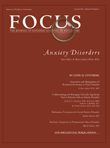Subtypes of Panic Attacks: A Critical Review of the Empirical Literature
Abstract
Background: Panic disorder is a heterogeneous disorder, comprising a variety of somatic, physiological, and cognitive symptoms during repeated panic attacks. As a result, considerable data have examined whether panic attacks may be classified into distinct diagnostic or functional subtypes. The aim of this study is to evaluate the existing literature regarding the validity of panic attack subtypes. Methods: This review focuses on data published since 2000, with the publication of DSM-IV-TR, augmented by replicated data published since 1980, with the publication of DSM-III and subsequently DSM-IV. Published reports evaluating empirical evidence for the validity of panic attack subtypes are reviewed. Results: Five sets of panic symptoms (respiratory, nocturnal, nonfearful, cognitive, and vestibular) have been shown to cluster together at varying degrees of consistency. However, none of these potential subtypes have been associated with sufficient and reliable external validation criteria indicative of functional differences. This apparent lack of findings may be related to methodological inconsistencies or limitations across the reviewed studies. Conclusions: Although at present the data do not warrant the utility of subtyping, further research aimed at patent gaps in the literature, including clearer operationalization of symptom subtypes, greater use of biological challenge paradigms and physiological and other more objective measures of fear and anxiety, and exploration of subtyping based on biological factors such as genetics, may support the future designation of panic attack subtypes and their ultimate clinical utility.
(This Article is being co-published by Depression & Anxiety and the American Psychiatric Association. This Article first appeared in Depression & Anxiety, 26:878–887 (2009).)



